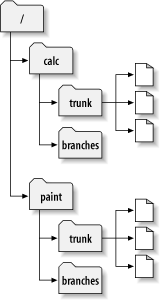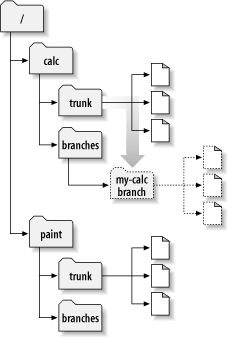4.2 Using Branches
| At this point, you should understand how each commit creates an entire new filesystem tree (called a revision) in the repository. If not, go back and read about revisions in Section 2.3.2. For this chapter, we'll go back to the same example from Chapter 2. Remember that you and your collaborator, Sally, are sharing a repository that contains two projects, paint and calc. Notice, however, that in Figure 4-2 each project directory now contains subdirectories named trunk and branches. The reason for this will soon become clear. Figure 4-2. Starting repository layout As before, assume that Sally and you both have working copies of the calc project. Specifically, you each have a working copy of /calc/trunk. All the files for the project are in this subdirectory rather than in /calc itself, because your team has decided that /calc/trunk is where the main line of development is going to take place. Let's say that you've been given the task of performing a radical reorganization of the project. It will take a long time to write, and will affect all the files in the project. The problem here is that you don't want to interfere with Sally, who is in the process of fixing small bugs here and there. She's depending on the fact that the latest version of the project (in /calc/trunk) is always usable. If you start committing your changes bit by bit, you'll surely break things for Sally. One strategy is to crawl into a hole: you and Sally can stop sharing information for a week or two. That is, start gutting and reorganizing all the files in your working copy, but don't commit or update until you're completely finished with the task. There are a number of problems with this, though. First, it's not very safe. Most people like to save their work to the repository frequently, should something bad accidentally happen to their working copy. Second, it's not very flexible. If you do your work on different computers (perhaps you have a working copy of /calc/trunk on two different machines), you'll need to manually copy your changes back and forth, or just do all the work on a single computer. By that same token, it's difficult to share your changes in progress with anyone else. A common software development best practice is to allow your peers to review your work as you go. If nobody sees your intermediate commits, you lose potential feedback. Finally, when you're finished with all your changes, you might find it very difficult to remerge your final work with the rest of the company's main body of code. Sally (or others) may have made many other changes in the repository that are difficult to incorporate into your working copy especially if you run svn update after weeks of isolation. The better solution is to create your own branch, or line of development, in the repository. This allows you to save your half-broken work frequently without interfering with others, yet you can still selectively share information with your collaborators. You'll see exactly how this works later on. 4.2.1 Creating a BranchCreating a branch is very simple you make a copy of the project in the repository using the svn copy command. Subversion is not only able to copy single files, but whole directories as well. In this case, you want to make a copy of the /calc/trunk directory. Where should the new copy live? Wherever you wish it's a matter of project policy. Let's say that your team has a policy of creating branches in the /calc/branches area of the repository, and you want to name your branch my-calc-branch. You'll want to create a new directory, /calc/branches/my-calc-branch, which begins its life as a copy of /calc/trunk. There are two different ways to make a copy. We'll demonstrate the messy way first, just to make the concept clear. To begin, check out a working copy of the project's root directory, /calc: $ svn checkout http://svn.example.com/repos/calc bigwc A bigwc/trunk/ A bigwc/trunk/Makefile A bigwc/trunk/integer.c A bigwc/trunk/button.c A bigwc/branches/ Checked out revision 340. Making a copy is now simply a matter of passing two working-copy paths to the svn copy command: $ cd bigwc $ svn copy trunk/ branches/my-calc-branch $ svn status A + branches/my-calc-branch In this case, the svn copy command recursively copies the trunk/ working directory to a new working directory, branches/my-calc-branch. As you can see from the svn status command, the new directory is now scheduled for addition to the repository. But also notice the + sign next to the letter A. This indicates that the scheduled addition is a copy of something, not something new. When you commit your changes, Subversion will create /calc/branches/my-calc-branch in the repository by copying /calc/trunk, rather than resending all of the working copy data over the network: $ svn commit -m "Creating a private branch of /calc/trunk." Adding branches/my-calc-branch Committed revision 341. What follows is the easier method of creating a branch, which we should have told you in the first place: svn copy is able to operate directly on two URLs. $ svn copy http://svn.example.com/repos/calc/trunk \ http://svn.example.com/repos/calc/branches/my-calc-branch \ -m "Creating a private branch of /calc/trunk." Committed revision 341. There's really no difference between these two methods. Both procedures create a new directory in revision 341, and the new directory is a copy of /calc/trunk. This is shown in Figure 4-3. Notice that the second method, however, performs an immediate commit. (Subversion does not support cross-repository copying. When using URLs with svn copy or svn move, you can only copy items within the same repository.) It's an easier procedure, because it doesn't require you to check out a large mirror of the repository. In fact, this technique doesn't even require you to have a working copy at all. Figure 4-3. Repository with new copy
4.2.2 Working with Your BranchNow that you've created a branch of the project, you can check out a new working copy to start using it: $ svn checkout http://svn.example.com/repos/calc/branches/my-calc-branch A my-calc-branch/Makefile A my-calc-branch/integer.c A my-calc-branch/button.c Checked out revision 341. There's nothing special about this working copy; it simply mirrors a different directory in the repository. When you commit changes, however, Sally won't ever see them when she updates. Her working copy is of /calc/trunk. (Be sure to read Section 4.5 later in this chapter: the svn switch command is an alternate way of creating a working copy of a branch.) Let's pretend that a week goes by, and the following commits happen:
Figure 4-4 shows that there are now two independent lines of development happening on integer.c.: Figure 4-4. The branching of one file's history Things get interesting when you look at the history of changes made to your copy of integer.c: $ pwd /home/user/my-calc-branch $ svn log --verbose integer.c ------------------------------------------------------------------------ r343 | user | 2002-11-07 15:27:56 -0600 (Thu, 07 Nov 2002) | 2 lines Changed paths: M /calc/branches/my-calc-branch/integer.c * integer.c: frozzled the wazjub. ------------------------------------------------------------------------ r341 | user | 2002-11-03 15:27:56 -0600 (Thu, 07 Nov 2002) | 2 lines Changed paths: A /calc/branches/my-calc-branch (from /calc/trunk:340) Creating a private branch of /calc/trunk. ------------------------------------------------------------------------ r303 | sally | 2002-10-29 21:14:35 -0600 (Tue, 29 Oct 2002) | 2 lines Changed paths: M /calc/trunk/integer.c * integer.c: changed a docstring. ------------------------------------------------------------------------ r98 | sally | 2002-02-22 15:35:29 -0600 (Fri, 22 Feb 2002) | 2 lines Changed paths: M /calc/trunk/integer.c * integer.c: adding this file to the project. ------------------------------------------------------------------------ Notice that Subversion is tracing the history of your branch's integer.c all the way back through time, even traversing the point where it was copied. It shows the creation of the branch as an event in the history, because integer.c was implicitly copied when all of /calc/trunk/ was copied. Observe what happens when Sally runs the same command on her copy of the file: $ pwd /home/sally/calc $ svn log --verbose integer.c ------------------------------------------------------------------------ r344 | sally | 2002-11-07 15:27:56 -0600 (Thu, 07 Nov 2002) | 2 lines Changed paths: M /calc/trunk/integer.c * integer.c: fix a bunch of spelling errors. ------------------------------------------------------------------------ r303 | sally | 2002-10-29 21:14:35 -0600 (Tue, 29 Oct 2002) | 2 lines Changed paths: M /calc/trunk/integer.c * integer.c: changed a docstring. ------------------------------------------------------------------------ r98 | sally | 2002-02-22 15:35:29 -0600 (Fri, 22 Feb 2002) | 2 lines Changed paths: M /calc/trunk/integer.c * integer.c: adding this file to the project. ------------------------------------------------------------------------ Sally sees her own revision 344 change, but not the change you made in revision 343. As far as Subversion is concerned, these two commits affected different files in different repository locations. However, Subversion does show that the two files share a common history. Before the branch-copy was made in revision 341, they used to be the same file. That's why you and Sally both see the changes made in revisions 303 and 98. 4.2.3 The Key Concepts Behind BranchesThe two important lessons that you should remember from this section are as follows.
|
EAN: 2147483647
Pages: 127